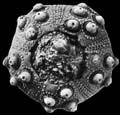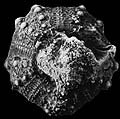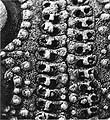The Echinoid Directory
Zardinechinus Kier, 1977, p. 16
| Diagnostic Features |
|
|---|---|
| Distribution | Late Triassic (Carnian and Norian); Peru, Italy and Vancouver, Canada. |
| Name gender | masculine |
| Type | Cidaris lancedelli Zardini, 1976, p. 12, by original designation. |
| Species Included |
|
| Classification and/or Status |
|
| Remarks |
|




